Tree motion sensor PiCUS TMS 3
Price: Liên hệ
| Model | PICUS TMS 3 |
| Manufacturer | ARGUS |
| Power supply | |
| Weight | |
| Size | |
| Condition | Còn hàng |
| Warranty | 12 tháng |
I. Specifications of PiCUS TMS 3 tree motion sensor
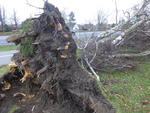
- The tree motion sensor PICUS 3 performs a measurement of the tree's wind response to check the depth of the tree to obtain information about the stability of the tree and is determined by its root anchoring force in the tree ground.
- PiCUS TMS 3 - the device that always innovates
- Bluetooth communication - control via mobile phone
- New inclinometer - quick and simple installation
- Small and compact and safe.
Method of measuring the wind response of trees:
- Wind response measurement is a measurement that records the swaying motion of a tree in a natural wind, by measuring the inclination of the base plate.
- Advantage:
- Plant response is measured directly, including all environmental influences.
- Include tree-specific parameters (size, crown form, etc.), wind strength and vent (buildings and other trees in the vicinity).
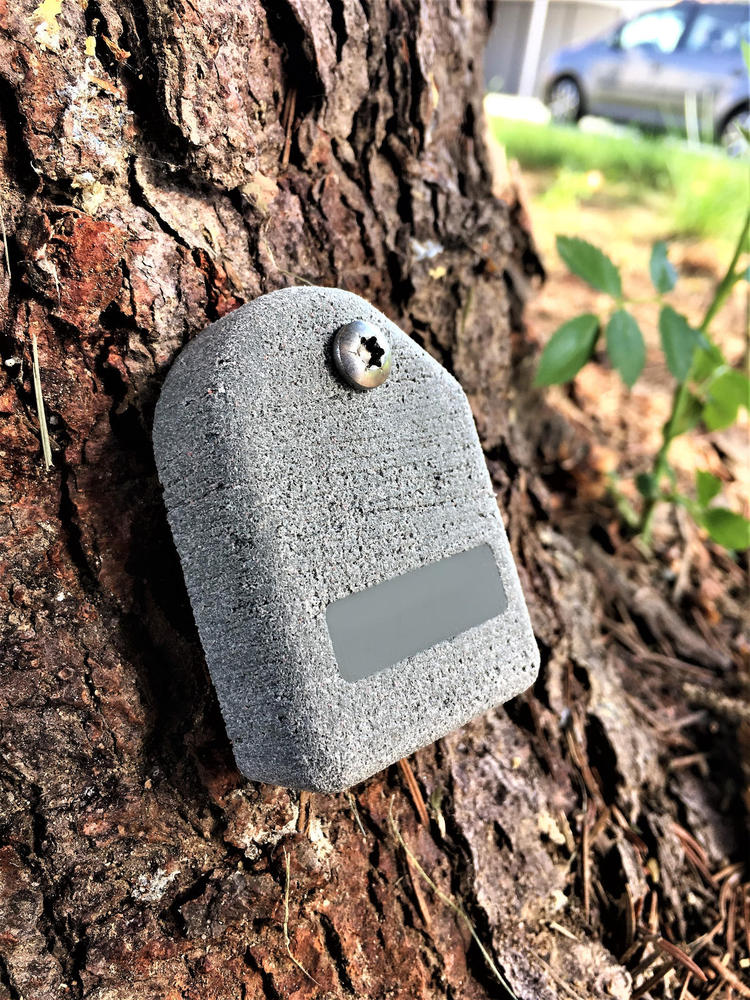
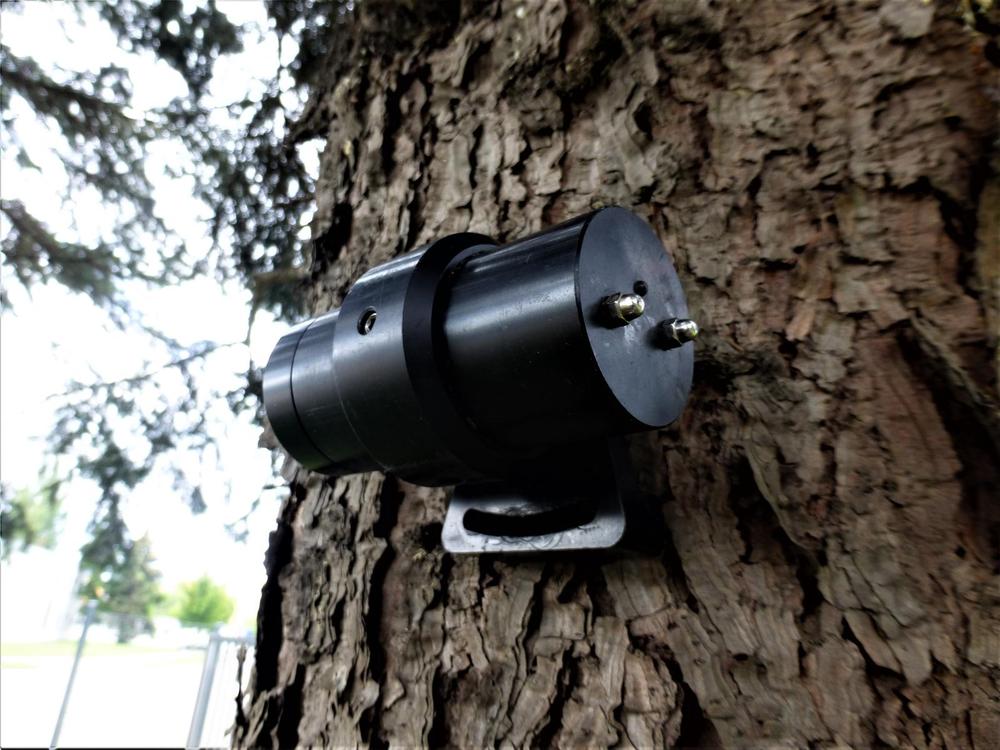
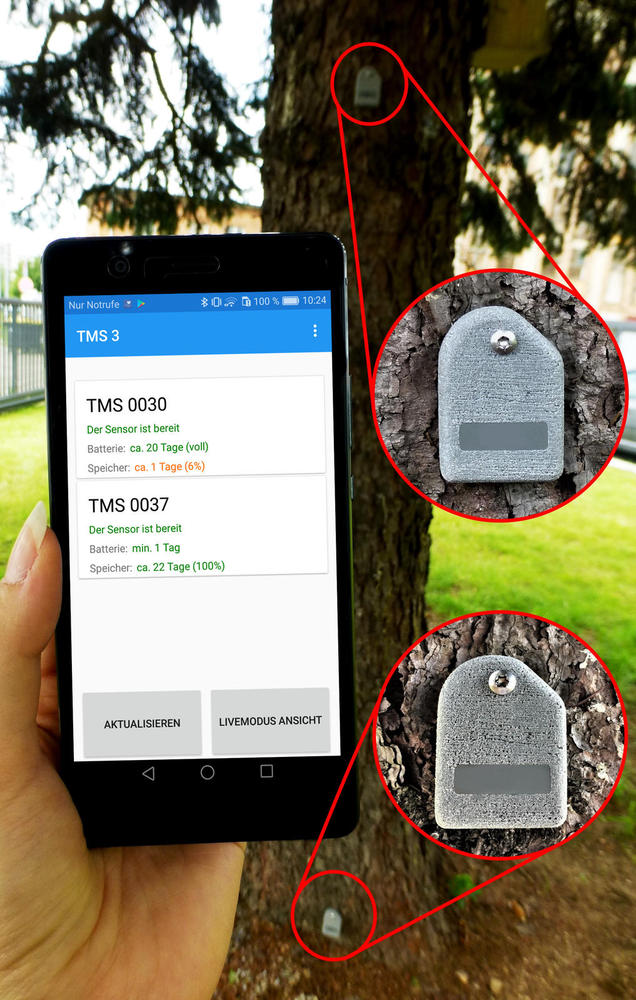
Typical applications for wind response measurements:
- Confirm the stability
- If the tree shows only a small inclination of the root plate, even in strong winds, a stable root system can be judged.
- Identify trees with root anchor problems
- After measuring groups of trees to compare the results, it is possible to identify trees with a conspicuously large slope.
- Combined with a static tree pull test ( TreeQinetic ) regarding stability
- If a tree with an increased inclination angle has been identified, it is significant to follow up with a static tensile test to measure the tree's response to a known force.
- Complementary to acoustic tomography (PiCUS Acoustic Tomography) and resistance tomography (TreeTronic 3)
- Trees with major defects in the lower trunk area (with a hypothetical root defect) should also be tested for their stability in the natural wind.
- Monitor trees near the construction site
- Continuous changes in tree inclination angle during tillage (e.g. laying of pile walls) can be detected using PiCUS TMS 3 tree motion sensor.
- Long-term tree monitoring
- Trees suspected of having root anchor problems can be checked periodically to check that:
- Roots tilted in the wind decrease (plants grow new and stronger roots)
- The inclination of the root plate in the wind increases (dead or other damaged roots)
- Reaction unchanged.
- Trees suspected of having root anchor problems can be checked periodically to check that:
II. Application of tree motion sensor
- Wind causes tilting of the root plate and bending causes bad and dangerous effects in the trunk. The PiCUS TMS is an inclinometer that can automatically record changes in the base plate inclination by hours, days or even weeks.
- Minimum test conditions: strong wind speed > 45 km/h.
Take measurements:
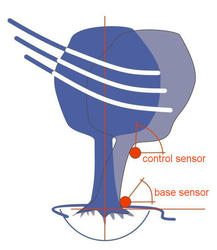
- Mount the sensor before a wind event (before the wind occurs), stop measuring after the wind calms down (minimum measurement time 2h)
- 2 PiCUS TMS per tree
- Base sensor on stem - direct measurement
- Base plate tilt control Sensor at 2-3m - to filter out ambient noise sources (e.g. road traffic) and to identify actual wind events
- Analyze from the comfort of your office, minimizing time in the field
- If the base sensor shows tilt while the control sensor doesn't, it's background noise.
- In the case of actual wind, the value of the control sensor should be higher than the base sensor, because the upper sensor measures not only the inclination of the base plate, but also the curvature of the stem.
III. Software features
- Software PC TMS
- Raw data visualization (tilt angle and direction)
- Function to identify and analyze tilt events
- Direct comparison of tilt values from different PiCUS TMS (usually base sensor and control on the same tree)
- Automatic data analysis and wind curve calculation
- Only PiCUS TMS 3
- Application for PiCUS TMS 3 tree motion sensor control:
- Show status
- Input of the prepared tree data
- Direct measurement mode.
- Expansion of PC program:
- Automatic reading out of PiCUS TMS 3 . measurement data
- Automated structuring of all incline and wind speed data by project (create database)
- Direct comparison of all measured inclination values of PiCUS TMS 3 (in the same tree)
- Direct comparison of wind curves from different trees
- Automatic reading and processing of anemometer data (recorded with the TMS Anemometer).
IV. Analyze and interpret measurement data
- The included PC software generates diagrams showing the relationship between wind speed and the base plate inclination - Wind Tipping Curves. Wind speed can be measured locally (TMS Anemometer System) or can be read and added manually from external sources.
- The ability to extrapolate the tilt, which gives wind speeds 10 to 20 km/h stronger than the measured ones, allows tree performance to be predicted with the aforementioned wind speeds.
- Example: Below are the results of wind curves from three Douglas firs measured during Hurricane Xaver (wind speeds up to 93 km/h, measured by a weather station about 9 km away)
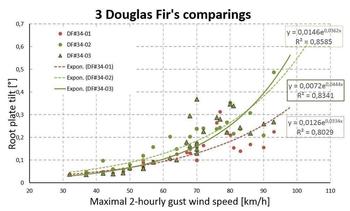
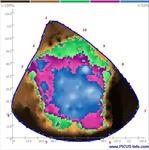
- The red curve is from a Douglas fir with both a major stem root defect and strong root swelling (see PiCUS sonogram). The other two curves are from neighboring trees with no defects in the trunk. It can be seen that the defective Douglas fir shows less inclination of the base plate than the reference trees.
V. Application example
Comparative analysis of tree groups:
- All trees in an Acer alley are fitted with a PiCUS TMS. This allows for rapid and simultaneous testing of all trees with little effort. Comparative analysis identified trees showing unusually high slope values, compared with other trees in the same group.
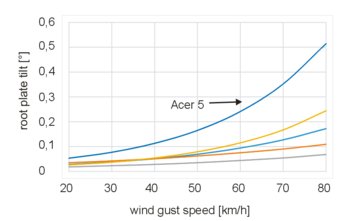
- Conclusion: In a direct comparison of the Wind Curves, it is clear that the acer 5 has a significantly higher inclination than the other four. Therefore, this tree needs to be examined much more closely (with other commonly used methods)
Single tree analysis:
- Computed tomography showing a large defect at the base of the trunk (tilia with Kretzschmaria deusta).
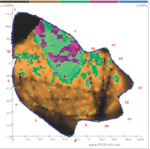
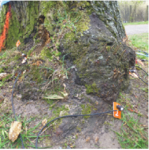
- Point 1 - The inclination of the base plate in wind speeds > 90 km/h was 0.7° (deciduous)
- Point 2 - Tilt extrapolation for wind speed 110 km/h: 1.4°
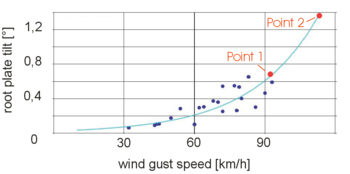
- Conclusion: According to the Generalized Wind Blows Curve (by Sinn/Wessolly/Erb 1998), a tree pulled to a 2–4° incline will fall without increasing the applied force (uplift). Therefore, the resistance of the tilia will not exceed a wind speed of 110 km/h.
VI. Optional anemometer
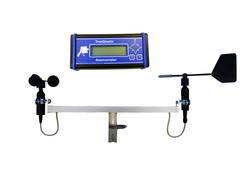
- TMS anemometer is a recorder and display of wind direction and wind speed data. It includes an anemometer, wind direction sensor and data logger. In addition, a 10 m long mast is available on which this unit can be mounted.
- The advantage of using an anemometer is that the wind data is collected in the vicinity and therefore a particularly good correlation of the wind and inclination data can be achieved. Furthermore, wind data is recorded with a high frequency measurement available. These advantages are particularly noticeable when the thin or geographically specific network of publicly accessible measuring stations allows the transfer of restricted area wind data to the test tree.
- A unique feature of the tachometer is the direct data entry into the TMS 3 Control software. The data logger uses a file format that can be used with subsequent intermediate steps with the data of the PiCUS TMS 3 sensors. Although foreign file formats cause additional work and are error prone Since manual adjustment is required, the direct connection of the data logger can be opened with just a few clicks and data transmission can be started.
| Data logger - technical data | |
| Supply voltage | 3,6 V via built-in LiPo battery |
| Current consumption | < 1 mA |
| Interface | USB 2.0 for communication with PC |
| Temperature range | -10 °C ... 60 °C |
| Dimensions (LxWxH) | 110 x 60 x 35 mm |
| Current consumption during charging | 350 mA |
| Charging time | ca. 4 h |
| Running time | ca. 30 days |
| Anemometer - technical data | |
| Supply voltage | 5 V DC |
| Current consumption | < 0,01 mA (5 V power supply, without external load) |
| Signal output | voltage pulse input near the supply |
| (16 pulses/revolution, loadable max. 5 mA) | |
| Measuring range | Anlauf < 0,3 m/s, bis 50 m/s |
| Temperature range | -20 °C ... 70 °C |
| Dimensions | 135 x 135 mm |
| Wind direction sensor - technical data | |
| Electricl outlet | voltage 0 ... 5 V DC |
| Suplly current | < 20 mA |
| Measuring principle | Hall effect absolute value encoder |
| Measuring range | run-up 0,2 m/s, 0 ... 360° |
| Temperature range | -25 °C ... 80 °C |
| Dimensions | height 140 mm |
| turning radius of the flag 150 mm | |
| Resolution | 1024 (10 Bit) / 4096 (12 Bit) |
| Update rate | 1,0 ms |
| Output load | > 10 kΩ |
VII. Mobile application
- To work with the new TMS 3 sensors it is necessary to download the associated App from the app store.

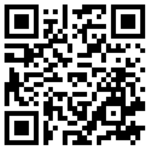
VIII. Specifications of Tree motion sensor PiCUS TMS 3
| Parameter | PiCUS TMS 3 | PiCUS TMS |
| General characteristics | ||
| Colour | grey | black |
| Weight | 73 g | 270 g |
| Dimensions | 61 mm x 41 mm x 20 mm | 100 mm x 80 mm x 75 mm |
| Protection | Completely sealed against water and dust | Protected against rain and dust |
| Min. livetime | 5 years | 5 years |
| Measurement | ||
| Accuracy tilt measurement | 0,03 ° | 0,03 ° |
| Measurement interval | 0,05 s (20 Hz) | 0,05 s (20 Hz) |
| Type of tilt measurement | 3D measurement | 2D measurement |
| Sensor orientation | arbitrary | horizontal |
| Accuracy temperature measurement | 1 °C | 1 °C |
| Temperature range | -20 – +50 °C | -20 – +50 °C |
| Battery | ||
| Battery capacity and runtime | 250 mAh; > 14 days | 2900 mAh; > 20 days |
| Charging | wireless | Micro USB cable |
| Charge duration | approx. 2 h | approx. 6 h |
| Recommended charging temperature | 5 – 35 °C | 5 – 35 °C |
| Memory | ||
| Memory type | MicroSD memory card | |
| Memory size | 256 MB | Up to 32 GB |
| Memory runtime | 20 days | > 130 days (1 GB memory card) |
| Communication | ||
| Standby- and measuring mode | Bluetooth Low Energy 4.0 | Micro USB cable |
| Data download | Bluetooth Classic 2.1 | MicroSD card reader |
| Handling | ||
| TMS power on | Magnetic key | Electrical switch |
| Outdoor-handling | BLE-capable mobile phone (Android, iOS) | Electrical switch |
| + TMS 3 App | ||
| Data download and analysis | PC with Bluetooth Classic | MicroSD card reader |
| + TMS 3 Control software (direct sensor interaction) | + TMS PC software | |
| PiCUS TMS-case | ||
| Power supply | 230 V AC, 50 Hz (adaptor) | 230 V AC, 50 Hz (adaptor) |
| Number of TMS-chargers | 10 (wireless charge bays) | 10 (MicroUSB cable charger) |
| Maximum number of TMS | 20 | 20 |
| weight, filled (screws, cables, 10 TMS) | 5,5 kg | 11 kg |
| Dimensions | 48 cm x 35 cm x 15 cm | 60 cm x 45 cm x 17 cm |
No comments yet
SIGN UP FOR A CONSULTATION
Please fill in the form below and send your comments and questions to GMGA, we will respond to your email as soon as possible.

COMMIT
100% new product

COMMIT
100% refund if the product is of bad quality and not as promised

DELIVERY
Nationwide

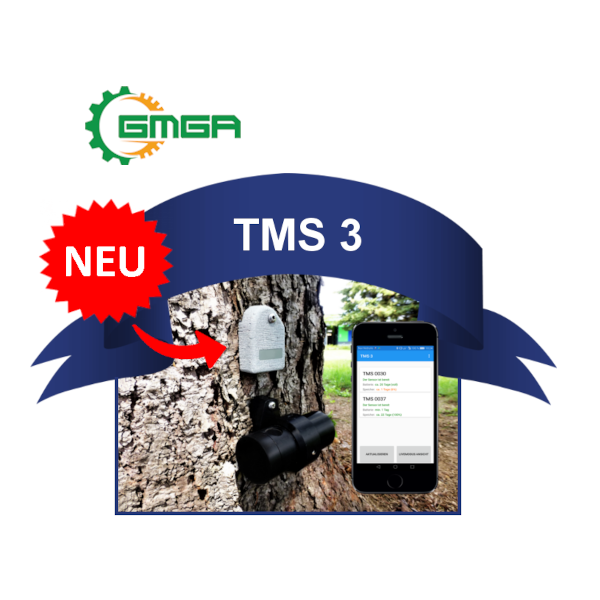
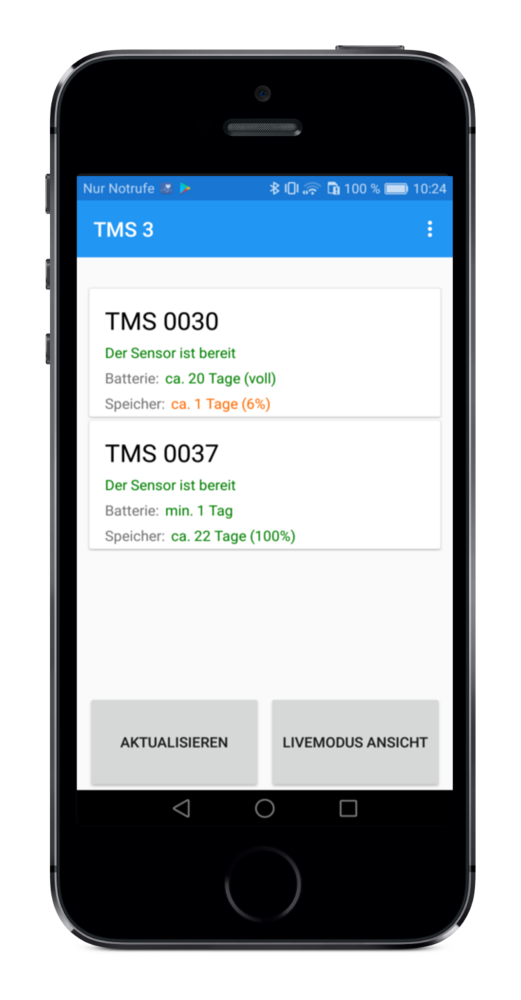
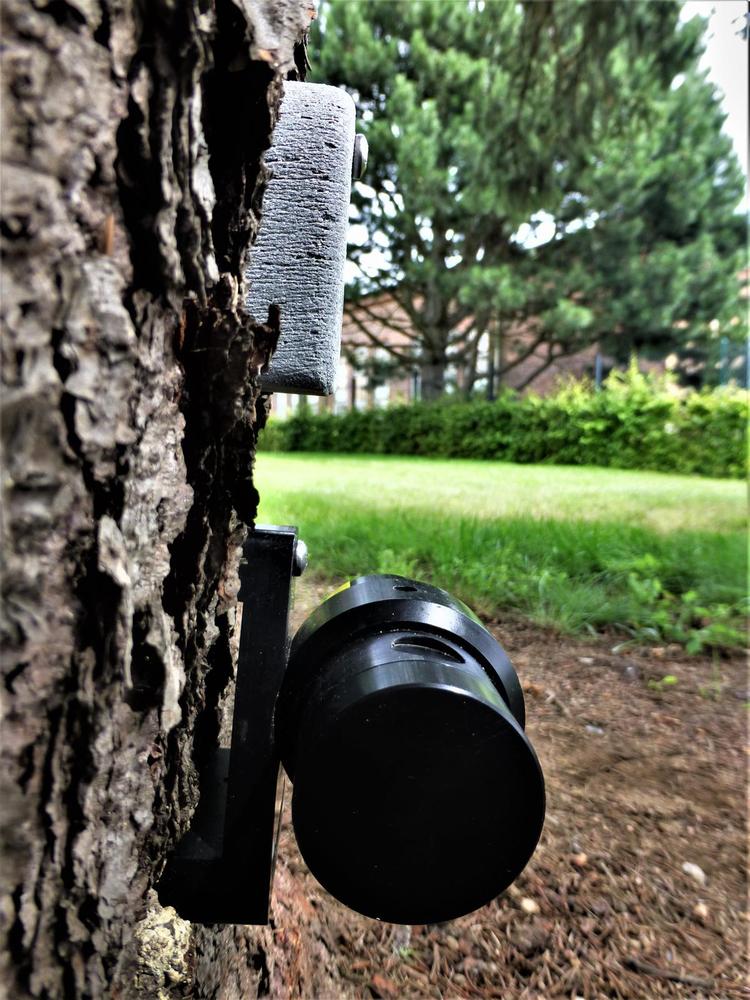

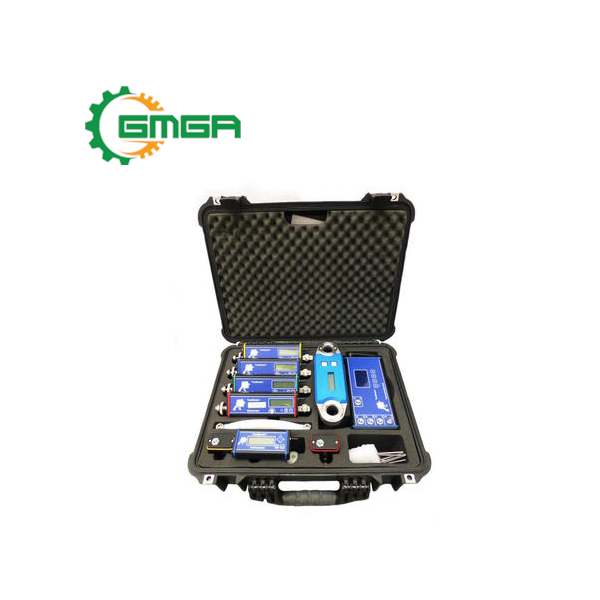

Review Tree motion sensor PiCUS TMS 3
There are no reviews yet.